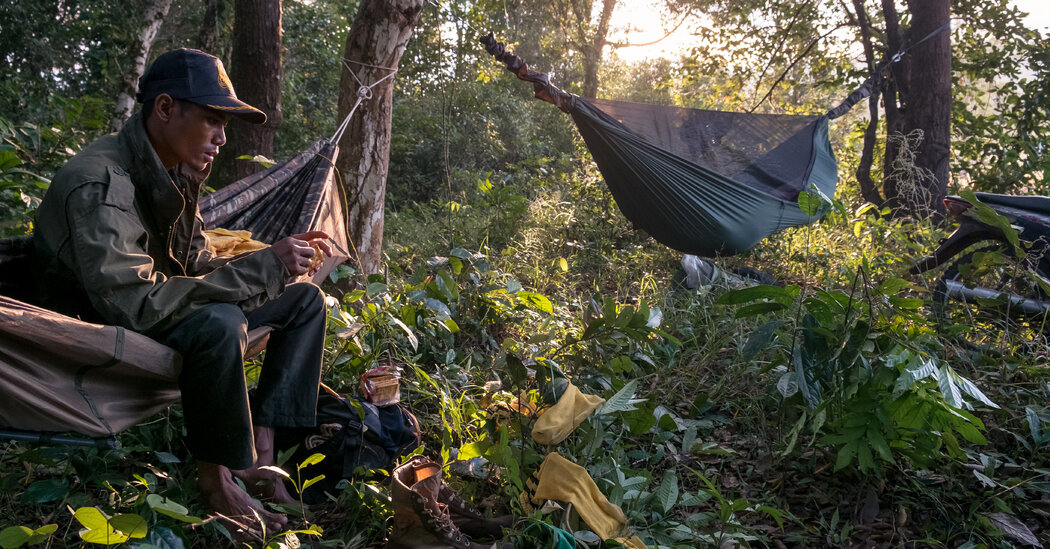
We were seated near a lush river in the Southern Cardamom Mountains, huddled over a lunch of chicken and rice, when the tip came in via text message: Someone had passed along the location of a poaching camp.
Within minutes, the entire group — including Darian Thackwell, the head ranger, and four of his armed team members — was rushing upstream. Eventually we hid our boat between a maze of mangroves and continued by foot, trudging our way as silently as possible through the thick vegetation.
For four days I’d been shadowing a group of men who patrol a region of this vast Cambodian rainforest, protecting the terrain and its wild animals from the relentless threats of illegal loggers and poachers. Deep in the remote southwestern province of Koh Kong, near the Thai border, we’d waded through rivers, gotten bogged down in the jungle and battled both the leeches and the unbearable humidity.
Now, the team of men employed by the Wildlife Alliance, a conservation group, was finally closing in on the poachers.
As we moved through the jungle, we found several homemade snares, of a kind typically used to catch civets or other small mammals. Darian guessed the poachers might not be too far. But then we reached what looked like a camp abandoned in haste: Hammocks, canned food, clothes and even two homemade guns had been left behind. I snapped a few photographs while the rangers dismantled the camp, confiscating the weapons and the snares.
Cambodia’s Cardamom Mountains were once a stronghold of the Khmer Rouge, the fanatical communist regime whose presence lingered in the area well into the 1990s. For decades, the region’s isolated villages had little contact with the outside world. Bloody battles were waged between local villagers and guerrillas. The use of land mines was prolific. Consequently, the surrounding rainforest survived as one of the most pristine expanses of wilderness in Southeast Asia.
As conflict eased and the land mines were cleared, the rainforest — along with its wildlife — was left vulnerable to illegal poachers, loggers and slash-and-burn farmers.
For the last two decades, a handful of environmental organizations has been racing against the clock to protect the area’s forests and the wildlife.
Wildlife Alliance is at the forefront of those efforts. The organization prioritizes round-the-clock law enforcement and collaboration with local authorities, ultimately providing hands-on protection to around 3 million acres of the Cardamom Mountains rainforest. It also aims to create eco-friendly job alternatives — focusing on education, reforestation and wildlife rehabilitation and release — for locals who were previously involved in, or might otherwise be pressured into, illegal trades.
The work of Wildlife Alliance is perhaps nowhere more evident than in and around the village of Chi Phat, which served as my base camp during my weeklong visit.
Reaching Chi Phat required a three-hour bus ride from Phnom Penh, Cambodia’s capital, followed by a two-hour boat ride on the Preak Piphot River. When I arrived, I was greeted by a series of idyllic scenes: a flurry of residents on bicycles, an improvised game of volleyball, an unpaved road fringed with colorful houses. On the river bank, small fishing boats were anchored on stilt houses, and a motorized raft ferried passengers from shore to shore: farmers with motorbikes, women carrying produce, children in their school uniform.
But the present-day rosiness is only recent history. For many years, a majority of the people who lived in this marginalized community took part in slash-and-burn farming or illegal logging and poaching.
It wasn’t until the mid-2000s, when Wildlife Alliance started to work with locals to create alternative sources of income, that Chi Phat began reversing those trends and establishing a series of community-based ecotourism initiatives.
Farmers were encouraged to adopt more sustainable farming techniques. At the same time, community members were rallied to reclaim lost tracts of forestland by rebuilding the soil and planting indigenous tree species. Since then, some 840,000 trees have been planted.
Moreover, onetime poachers — who had intimate knowledge of the rainforest and its wildlife — were recruited, trained and equipped to become protective rangers. Armed, they now patrol the area on foot, by motorbike, by boat and by air, protecting the environment from poachers and loggers.
Corruption and the financial lure of illegal trades and large-scale business development projects are still a threat. But with an ever-increasing number of locals working alongside the conservationists, saving the forest is no longer a lost cause.
Chi Phat’s location at the foot of the Cardamom Mountains makes it a prime place for wildlife tourism. A number of traditional Cambodian homes have been turned into guesthouses, and English-speaking trail guides lead hikers on trails that cut through emerald hills, mountain streams, rapids and waterfalls. Intrepid travelers can also visit a handful of scattered rural communities, along with a few ancient Khmer archaeological sites.
Like many areas dependent on tourism, Chi Phat was hard hit by the pandemic. In 2020, visitor numbers dropped by more than 80 percent, undercutting one of Wildlife Alliance’s major fund-raising sources.
But the pandemic has also underscored the importance of stemming the illegal wildlife trade, whose markets are known to harbor pathogens that can jump to humans.
Binturong, sun bears, clouded leopards, pangolins, civets, macaques and a vast array of birds are among the animals found here, many of which I encountered at a wildlife release station tucked away in the middle of the forest. At the station, animals that have been rescued from the illegal wildlife trade, or that were found in snares or in captivity, are rehabilitated and released.
During the two days I spent at the release station, I went on several walks with Soeun, the facility’s caretaker. A kind and composed man, he introduced me to the animals as if they were members of his family — one by one, and with profound grace and care. He lived with and for them.
Soeun, who grew up in the area in an impoverished farming community, had once participated in illegal poaching as a way to provide for his family. But when Wildlife Alliance set up the release station in 2008, he instead began caring for and releasing the animals. He’s worked for the organization ever since.
On a walk together, Soeun and I passed a small sandalwood grove set among the dense verdant hills. We spotted two sun bears climbing one of the trees, likely in search of a beehive.
Soeun recognized the animals. With a clear sense of pride, he explained that the bears had arrived at the station, injured, two years earlier — and that he had personally helped to rehabilitate and release them.




